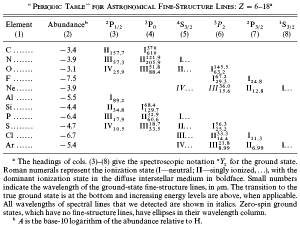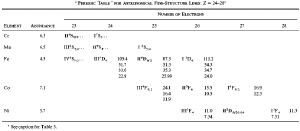|
Supernova Remnents -- SNRs (see
the wikipedia
definition)
 | ISO LWS/SWS observations of three SNRs W28, W44, and 3C 391, revealed rich atomic fine-structure lines from C+, N+, N++, O0,
O++, O+++, Si+, P+, and Fe+,
and two H2 lines S(3) and S(9). No single shock
model can account for all these detected lines. They find that the major coolants of radiative supernova shocks in
moderate-density gas (~102 cm−3) are the
far-infrared continuum from dust grains
surviving the shock, followed by collisionally excited [O
I] 63.2 μm and [Si II]
34.8 μm lines. The principal coolant of
the high-density (~104 cm−3) shocks is
collisionally excited H2 rotational
and ro-vibrational line emission. The presence
of bright [Si II] and [Fe II] lines requires partial
destruction (~1/3 destruction) of the dust. They prepared a periodic
table for all possible hyperfine structure lines (only for abundant elements
with p shell electrons). (from Reach & Rho, 2000ApJ...544..843R)
(figs: periodic table for all possible
hyperfine structure lines)
  |
 | Cross-correlation between all 95 known SNRs
and Spitzer GLIMPSE
3.6, 4.5, 5.8 and 8um images within 10deg < l < 65 deg and |b| <
1deg resulted in 18 matches without confusion. Infrared emission from supernova remnants originates
from synchrotron emission, shock-heated dust (PAH or small grains), atomic fine-structure lines (coolants), and molecular lines (coolants). The detected remnants are
G11.2-0.3, Kes 69, G22.7-0.2, 3C 391, W44,
3C 396, 3C 397, W49B, G54.4-0.3, Kes 17, Kes 20A, RCW
103, G344.7-0.1, G346.6-0.2, CTB 37A, G348.5-0.0, and G349.7+0.2.
The infrared colors suggest emission from molecular
lines (nine remnants), fine-structure lines (three
remnants), PAH (four remnants), or a
combination. None of the remnants are dominated by
synchrotron radiation at mid-infrared wavelengths. The IRAC-detected
sample emphasizes remnants interacting with relatively dense gas, for which
most of the shock cooling occurs through molecular or ionic lines in the
mid-infrared. (from Reach et al., 2006AJ....131.1479R) |
|
![]()